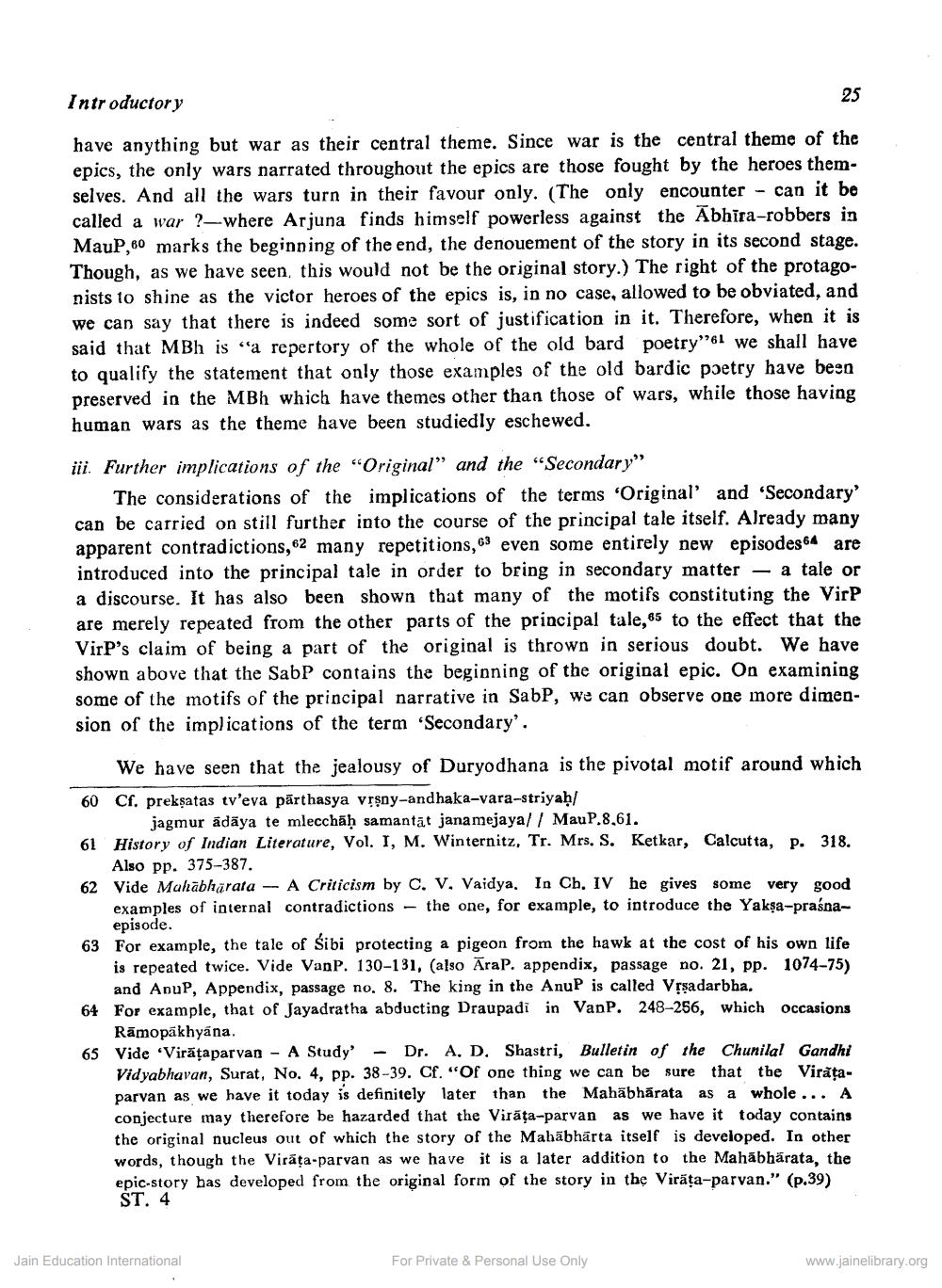________________
Introductory
have anything but war as their central theme. Since war is the central theme of the epics, the only wars narrated throughout the epics are those fought by the heroes themselves. And all the wars turn in their favour only. (The only encounter can it be called a war ?-where Arjuna finds himself powerless against the Abhira-robbers in MauP,60 marks the beginning of the end, the denouement of the story in its second stage. Though, as we have seen, this would not be the original story.) The right of the protagonists to shine as the victor heroes of the epics is, in no case, allowed to be obviated, and we can say that there is indeed some sort of justification in it. Therefore, when it is said that MBh is "a repertory of the whole of the old bard poetry" we shall have to qualify the statement that only those examples of the old bardic poetry have been preserved in the MBh which have themes other than those of wars, while those having human wars as the theme have been studiedly eschewed.
iii. Further implications of the "Original" and the "Secondary"
e
The considerations of the implications of the terms 'Original' and 'Secondary" can be carried on still further into the course of the principal tale itself. Already many apparent contradictions, 2 many repetitions, even some entirely new episodes are introduced into the principal tale in order to bring in secondary matter a tale or a discourse. It has also been shown that many of the motifs constituting the VirP are merely repeated from the other parts of the principal tale, to the effect that the VirP's claim of being a part of the original is thrown in serious doubt. We have shown above that the SabP contains the beginning of the original epic. On examining some of the motifs of the principal narrative in SabP, we can observe one more dimension of the implications of the term 'Secondary".
25
We have seen that the jealousy of Duryodhana is the pivotal motif around which
60 Cf. prekatas tv'eva pärthasya vrsny-andhaka-vara-striyaḥ/
jagmur adaya te mlecchaḥ samantat janamejaya// MauP.8.61.
61 History of Indian Literature, Vol. I, M. Winternitz, Tr. Mrs. S. Ketkar, Calcutta, p. 318. Also pp. 375-387.
62 Vide Mahabharata - A Criticism by C. V. Vaidya. In Ch. IV he gives some very good examples of internal contradictions the one, for example, to introduce the Yaksa-praśnaepisode.
63 For example, the tale of Sibi protecting a pigeon from the hawk at the cost of his own life
is repeated twice. Vide VanP. 130-131, (also AraP. appendix, passage no. 21, pp. 1074-75) and AnuP, Appendix, passage no. 8. The king in the AnuP is called Vṛṣadarbha.
64 For example, that of Jayadratha abducting Draupadi in VanP. 248-256, which occasions Ramopakhyana.
65 Vide 'Viraṭaparvan A Study' Dr. A. D. Shastri, Bulletin of the Chunilal Gandhi Vidyabhavan, Surat, No. 4, pp. 38-39. Cf. "Of one thing we can be sure that the Virățaparvan as we have it today is definitely later than the Mahabharata as a whole... A conjecture may therefore be hazarded that the Virața-parvan as we have it today contains the original nucleus out of which the story of the Mahabharta itself is developed. In other words, though the Virața-parvan as we have it is a later addition to the Mahabharata, the epic-story has developed from the original form of the story in the Virața-parvan." (p.39) ST. 4
Jain Education International
-
For Private & Personal Use Only
www.jainelibrary.org




